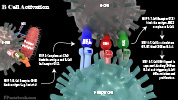II. Definitions
- B-Lymphocyte (B Cell)
- B-Cells are responsible for Humoral Immunity
- B-Cells are named for where they were first found (Bursa of Fabricus in birds)
- Responsible for Antigen-specific Antibody (plasma cells) and secondary future responses (memory cells)
III. Physiology: General
- Derivation
- Fetal Liver
- Bone Marrow Pluripotent Stem Cells
- Peripheral Migration to Secondary Lymphoid Tissue
- Spleen
- Lymph Nodes
- Peyer's Patches (Small Bowel)
IV. Physiology: B-Cell Activation
- Images
- Recognition
- Antigen binds B-Lymphocyte Surface Receptor (BCR)
- BCR binding activates B-Lymphocyte
- T-Cell Independent Antigen (e.g. inert Antigens) alone activate B-Cells
- Signal 1
- B-Cell Surface Receptor (BCR) binding to Antigenic Epitopes (repeat Amino Acid sequences)
- Signal transduced from cell surface to into cell via Ig alpha and beta
- Signal 2
- B-Cell co-receptor complex associated CR2 binds Antigen-bound Complement C3d
- Signal 1
- T-Cell Dependent Antigen (e.g. Microbes) require added stmulus (i.e. T Helper Cells)
- B-Cell Surface Receptor (BCR) binds Antigen AND
- B-Cells processes and presents Antigen to CD4+ T-Cells (T helper cells)
- CD4+ T-Cells (T helper cells) are activated by B-Cell surface Antigens and their co-stimulators
- Signal 1 for T-Cell Activation
- MHC Class 2 - Antigen Complex bind T-Cell Receptor (TCR)
- Signal 2 for T-Cell Activation
- Signal 1 for T-Cell Activation
- B Cell proliferation and differentiation is stimulated by T Helper Cell binding
- B-Cell CD40 surface Protein is bound by the Cytokine T Helper Cell CD40 Ligand
- Cytokines (IL2, IL4, IL5) are released by activated T-Helper Cells
- T-Cell Independent Antigen (e.g. inert Antigens) alone activate B-Cells
- B-Cell Proliferation
- Activated Lymphocytes proliferate
- B-Cell Differentiation
- Plasma Cells (Antibody producing cells)
- Survive for days to weeks producing antibodies, and without replicating
- Primarily found in Lymph Nodes and Spleen
- Memory Cells
- Plasma Cells (Antibody producing cells)
V. Physiology: Plasticity
-
Isotype Switching
- Antibody isotope type (e.g. IgE, IgG, IgM) are defined by the Antibody constant regions (C-Regions)
- The C-Regions may be abruptly modified to switch to production of a different Antibody isotope
- Example: A B-Cell may switch to IgE production in the case of Parasitic Infection
-
Immunoglobulin Gene modifications in response to Antigen detection
- Antibodies contain hypervariable regions within the variable section (Fab Component)
- Hypervariable regions (complementarity-determining region or CDR)
- Three heavy chain hypervariable regions
- Three light chain hypervariable regions
- In response to infection, hypervariable region genes may be rearranged to respond specifically to the organisms
- Variations in variable and hypervariable genes result in increased production of organism specific Antibody
VI. References
- Guyton and Hall (2006) Medical Physiology, p. 419-50
- Mahmoudi (2014) Immunology Made Ridiculously Simple, MedMaster, Miami, FL

